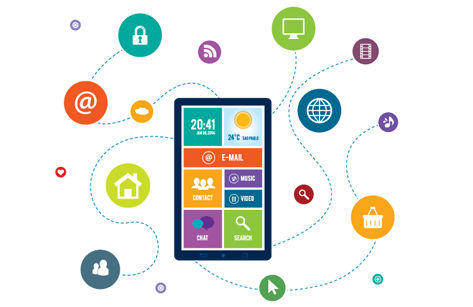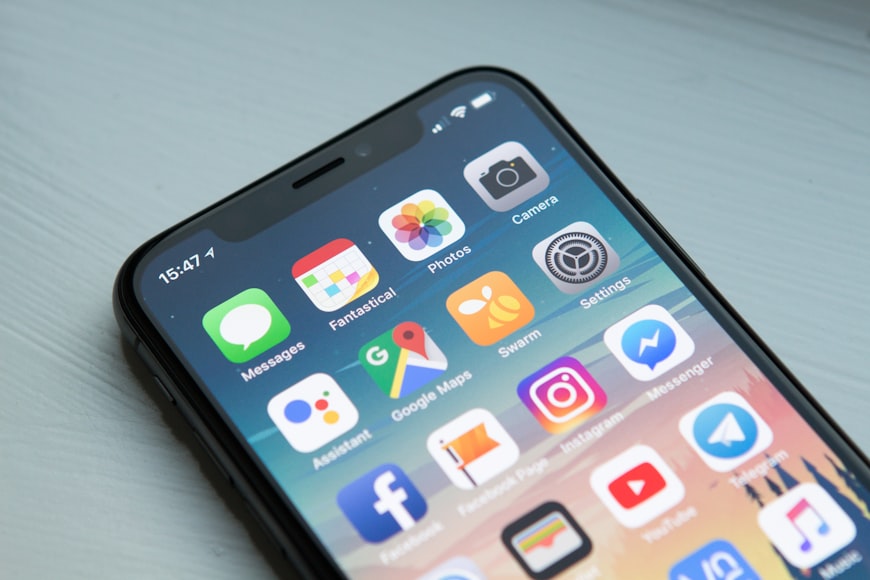
6 Steps to Mobile App Development: A General Gist
As of December 2021, it is estimated that there are 3.8 billion smartphones users in the world. This is a huge number of people who can potentially be target customers for a mobile app. Among them, 6.3% are said to have some form of phone addiction. This means that more than 239 million people are addicted to smartphones in one way or another. Is this an opportunity to grasp? Definitely yes. Even if we leave aside the heavily dedicated people, there are still more than enough people to target if you play your cards right. Yes, we are talking about getting profit through mobile applications and custom software products for mobile.
Smartphones have become a norm in urban areas. Due to this, businesses have begun to use this platform as a way to gain more customers and make the lives of their existing customers easy.
A common example of this is the apps developed by Banks to enable e-banking. And the effects of using mobile apps for business are within expectations. They are indeed effective. So if you are a new and upcoming business, you might already have thought of developing a mobile app for your own business. But do you know how it is developed?
Regardless of if you want to develop a mobile app for your business or just to earn extra cash through a premium subscription as an influencer, it is always a good idea to know what goes behind the scenes. By doing this, not only will you have a clear grasp of the process but you can also prevent yourself from being scammed. This is exactly what we will be talking about here - the mobile application development process.
Ready to know the secret behind the scenes? Let's get started then!
Process of Mobile App Development
As with everything else, there is a series of procedures for mobile application development as well. To develop a mobile app, the developer needs to first understand and analyze the needs of their customer, create a roadmap and then finally move on to build the mobile app. But this is not the end of the process as the developers still need to create a prototype and beta test the app to see the response before launching the official app.
Along with this the developer also needs to consider the laws and regulations regarding the sales and distribution of mobile apps. This is the general gist of the entire process. Let's go into more detail now!
1) Setting up the Mobile App Development Strategies
Contrary to what people think, building a mobile app is just a small part of the entire process. The majority of the mobile app development process is about planning and building solid guidelines. For this, the developer needs to have a strategy. This includes everything from finding out what the client needs to make an outline of the team members, defining marketing strategies (both digital marketing strategies and physical marketing strategies) for the mobile app, and knowing the rules and regulations one needs to follow. Setting up a strategy for mobile development is one of the most time-consuming aspects of the entire mobile app development process. So if you are thinking of getting a mobile app developed, you need to get the developer to know a few things. These things include:
The Objective of Mobile App
Know what you intend to do with your mobile app. Is it to fulfill a niche market or to connect with your existing users? Does your mobile app intend to attract customers or is your mobile app meant to entertain your users? Do you want to use your mobile app to enable premium services for your existing business or is it just meant to notify your current userbase? Is your mobile app meant to let the users communicate or to share files? Know these things clearly before proceeding into the process of mobile app development. Once things progress, it would be hard to change the objective mid-way.
Competitor Analysis
So now you know what you intend to do with your mobile app, how about the competitors? The changes are unless you are aiming for a highly specific niche market, you will have competitors. Do they have their mobile app? If yes, how does it function, and how popular is it? knowing your competitor is a great way to gain an advantage in business. If they have a mobile app, you should know and then decide the features that make your mobile app better than theirs. if not, then you have the higher ground.
Investments and Deadlines
Another thing that you need to consider is the aspect of money and time. Time is money and the quicker you need the mobile app, the more it will charge. Along with this, the price increase along with the addition of features as well. This is the part of mobile application development where you and the developers find out the best way to combine your budget, limited time, and necessary features to give you the best within your limitations.
Marketing Strategies and Legality
Once the budget has been decided, it's time for market strategy. This process involves knowing how you want to distribute your mobile app, knowing the legalities binding your mobile app, and finding out the best method to gain users. If your mobile app is meant only for a small group of loyal audiences and doesn't have too many features, this process will be quite easy. But if you want your mobile app to distribute among a wide range of audiences or is filled with features, then you may need to use the Play Store or Apple App Store.
Do note in this phase of mobile app development both you and the developers will have tons of meetings to strategize about the aspect mentioned here or you can do this on your own and present your strategy to the developers.
2) Team Selection
After the general strategy has been made, it's time for team selection. Now while the team members will generally consist of programmers, some supervisors are still required. The supervisors can be from your team or you can leave this responsibility completely to the developers. Along with selecting the supervisors, the marketing team, developing teams, and overall charge will also be decided in this process. Depending on the scale of your app, the team members can range from 5 to 50 including the non-programming members.
Along with this, the question of whether to outsource or not will also be answered in this phase of mobile app development. Sometimes, the organization can be overbooked with work or might not have adequate team members who desire their competence. Due to this, the need to outsource may arise. Besides this, you as a customer can also let your stakeholders participate in the mobile application development process.
Depending on the team, the process can either go extremely smoothly or encounter bumps. As someone once said - communication is the key to enhancing the competence of the development teams. So it is necessary to select the team members carefully.
3) Sketch out how your app will solve the problem and find a mobile solution
In this phase of mobile app development, both you and the developers will think of the ways how you can solve the problem, enhance the experience or fill the niche. Both you and the developers would have a clear understanding of what your app is meant for - now it's time for the How. This will not be a one-sided effort since both you and the developers will have something to offer. The developers will guide you on what can be done technically and practically while you will be inputting ideas about the features that can fix the issue.
This phase can last quite a long time since knowing the issue is easier than solving it. For instance, you may want a mobile app that is meant to enable your customers to read books online for free but with advertisements now and then. In this circumstance, you will need to consider how to give them access, where to store the database of the books, the frequency of add, track the user activity to update and enhance their experience, track their progress of the book they are reading, and so on. The main point in this phase of mobile app development is to finalize the features of the app and make it unique.
4) Build a road map and select the right tools
With the step of finalizing the features of the app, you as a customer can step out of the mobile app development process and leave the rest to the developers. After all the information has been collected and sorted out, the developers will first build a road map for mobile application development.
If you don't know what a road map is, it is planning the step-wise process of developing the app. In this phase, the mobile app developers will divide the entire development process into smaller chunks and find out the best ways to efficiently complete the development process - similar to how web developers. Once the road map has been finalized, they then choose the best tools to develop your mobile application and custom software for your mobile.
The thing with programming is that there is a wide range of tools one can use. While there are some aspects of coding that can only be executed by a specific tool, you can also use a wide range of tools to get the same outcome. So it is necessary to choose the best tool possible. Additionally, a single mobile app development tool can serve many other functions. So the selection process can get quite complicated.
Regardless of these, by the end of this phase of mobile app development, the developers will be ready to start coding and building the mobile app.
5) Start the development
After much deliberation, planning, and thinking, it is finally time for the mobile application developers to start creating the actual app itself. In this phase, the developers use a multitude of programming languages and tools to develop a mobile app that you need and make it as seamless as possible. While nothing much goes on in this process besides coding, there are still some aspects that the developers need to consider during this process. These things are:
Applying automation
A mobile app needs to be automated wherever possible. Since these are meant to make the lives of both parties easier, it would be a waste if everything about the app needs to be handled manually.
Enabling cloud services
While storing data on physical devices is simpler, it is also not the safest option. Since most mobile applications use the internet in one way or another, enabling cloud services is one of the must-do things. Not only will this enable more storage but is a great way to prevent data loss from damage to devices.
Use of optimum tools
As we mentioned before, a developer should use the best tools at their disposal to complete the mobile app development process easily and efficiently. They need to consider the versatility as well as the function of the tool they are using while they build the app
Testing and debugging
It is said that programming is just half of the task - the rest is testing and debugging. Regardless of how careful a developer is, there are bound to be some small bugs in a program. Even if there are none, the program may not function as intended. Due to this, constant testing and debugging are a necessary part of mobile app development.
Continuous communication with the client
A mobile app developer constantly needs to keep in touch with the client during the development process. This can be forgiving updates or asking for additional instruction regarding changes or issues.
6) Prototype and Beta-testing
Once the coding phase of the mobile app development is completed, the result might still lack some aspects of what you want or may need some modification. Due to this, this first product of the mobile application development process steps is called a prototype mobile application. The developers will first ask you to use this pre-release mobile app and take your review. You may also be asked to let a few trusted people test the mobile app for review. This is exactly what beta testing is. The developers take in input from the beta testers and then modify the mobile app before the final release.
While the instances of the prototype being the final product are fairly common, beta-testing is still a necessary step as not every mobile app works as intended. After beta-testing is done and modification is made, the mobile app development process steps finally come to an end.
In the end,
The Mobile App development process steps are just like any other web development process. The bulk of the time is consumed on planning and strategizing the process while the primary programming is relatively short. Of course, depending on the skill of the developers, it can still take a few weeks to a few months to program the app.
However, you do have to remember that planning for the development can easily take a few months. The good thing about the planning phase of mobile app development is that you don't need to approach the developers if you have someone with the know-how. While you still will need to meet them and discuss what you need as well as select and finalize the development teams, you can approach the developers with your strategy.
By now you should know that mobile apps are an essential asset for any organization that wants to increase its influence. Unless you are the one developing these applications, you better get one. You can easily get mobile applications in the Play Store and other mobile app stores if you are curious about mobile application development or just require someone to do the job for you why not give us a nudge by following the link here? And if you want to know more about web and app developments, you can follow this up with the articles below.






